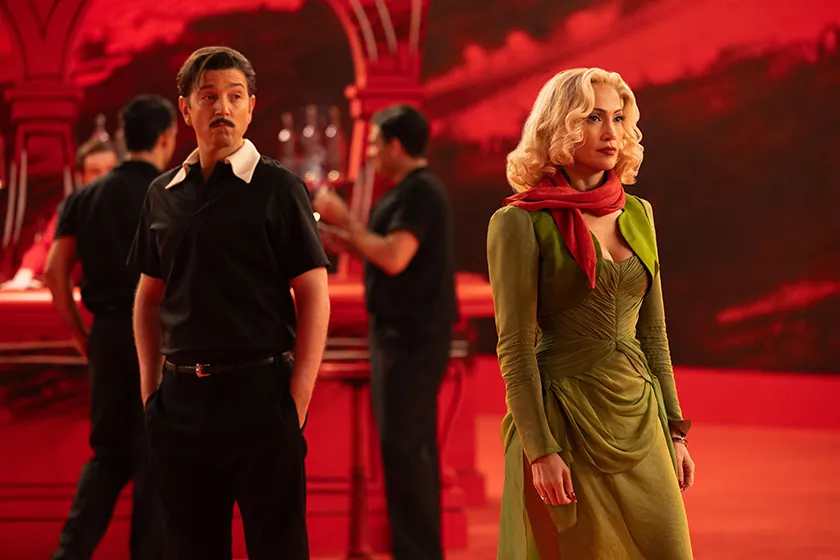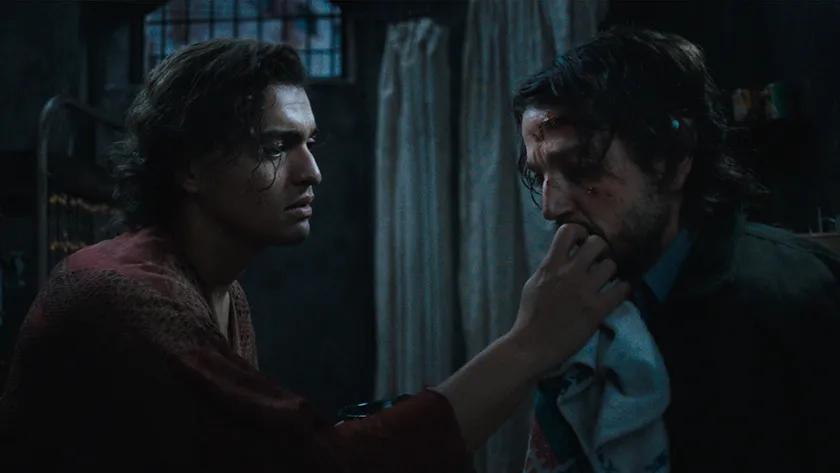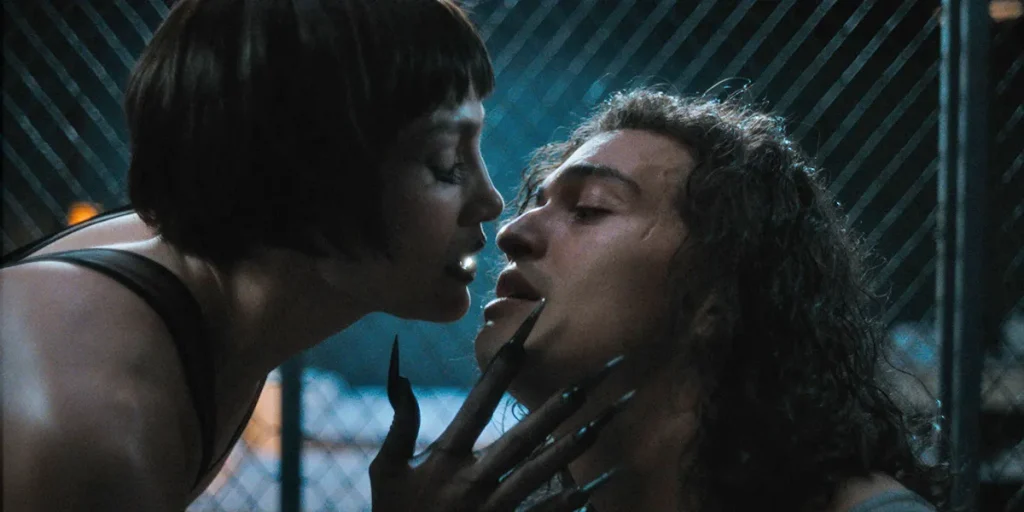Bill Condon’s Kiss of the Spider Woman is an uneven but lovely film about the power of art, and finding love in the most unusual places.
Director: Bill Condon
Genre: Prison Drama, Political Drama, Musical
Run Time: 128′
Rated: R
U.S. Release: October 10, 2025
U.K. Release: TBA
Where to Watch: In U.S. theaters
Kiss of the Spider Woman is many things. First and foremost, it’s a sweet and sentimental testament to the importance of art. It’s a love story told across timelines and realities. It has a message about revolution, though its politics are lacking elsewhere. And it’s an enjoyable, if inconsistent, lushly filmed addition to the storied movie-within-a-movie genre.
This text has been through many adaptations. Originally based on a 1976 novel, it has been adapted into a Tony award-winning stage musical and an Oscar-winning film, among others. Bill Condon’s decadent love letter to Technicolor joins an esteemed tradition. Condon’s version is set in the 1980s in an Argentinian prison, where Luis Molina (Tonatiuh, Carry-On) is newly incarcerated, and sharing a cell with Valentín Arregui (Diego Luna, Y Tu Mamá También). Molina is a gay man convicted of “public indecency,” and Valentín is a political prisoner with information about the ongoing revolution that he refuses to give up.
Molina greets his new cellmate with all the enthusiasm of a kid at summer camp, hanging movie posters on the dank cell walls. Valentín refuses to interact, preferring to keep his nose in his political books, and calling Molina by his last name only. He is merely amused by Molina’s attempts to bond with him, which he does by recounting the plot of his favorite melodrama, Kiss of the Spider Woman. Molina’s idol, the fictitious Hollywood starlet Ingrid Luna stars in the film-within-a-film. She is played by Jennifer Lopez (Hustlers), in a musical role was absolutely made for.
Valentín is initially dismissive of the film, calling it clichéd and unrealistic. But as the pressure on him worsens within the prison walls, he finds himself seeking comfort in cinematic escapism. As Molina shares the story, the pair’s bond strengthens, becoming a consistent heartbeat thumping underneath the showmanship of Lopez’s storyline. Together, they experience betrayal, torture, and intimacy, creating an unlikely and moving connection despite their surroundings. True to the genre, the events of one film soon begin to mirror the other, with the color, spectacle, and tragedy of the musical bleeding into the grim events taking place inside the prison.
The fictional Kiss of the Spider Woman centers around Ingrid Luna’s character Aurora. Aurora is a well-to-do magazine editor who seemingly has it all, except she is doomed to lose the love of her life once she finally finds him. As she falls for a man named Armando, she realizes she must push him away in order to spare his life from the mythical “Spider Woman” who will demand him as a sacrifice.
Hammering home the connections between timelines, all three lead actors play multiple characters, with Diego Luna starring as Armando and Tonatiuh as Aurora’s devoted assistant Kendall Nesbitt. Lopez also portrays the Spider Woman, who appears in a multitude of gossamer, sculpted gowns in black and silver. The effect is sensational, and the costuming, created by the legendary Colleen Atwood whose handiwork can most recently be seen in Paul Thomas Anderson’s One Battle After Another, is a standout part of the film. The price of your ticket is worth it for the green gown Lopez tears apart mid-dance scene alone.
Her outfits aren’t the only thing that turn Aurora into an utterly captivating figure you can believe would go down in cinema history. Lopez shines in the role, sticking every note and sharp dance move with lethal accuracy. The part is fun, liberated, and a fabulous homage to the divas of classic Hollywood.
Both stories exalt the visuality of Technicolor musicals and melodramas. Molina’s nostalgic return to the films of his youth provide much-needed solace, and he waxes rhapsodic about real actresses as well, like Joan Crawford in Mildred Pierce. In Aurora’s timeline, several stunning dance sequences play out in artful detail—one a cute, romantic duet set in a darkroom, another an epic group performance in a lustfully red nightclub. Movie musical purists, have no fear: the dance numbers are framed through sweeping wide shots, resisting the trendy but mystifying urge to cut so frequently that the dancers get lost. The colors of the setpieces are positively lurid, peacock blues and electric greens that remind you movie musicals are meant to enhance the beauty of live theater, not wash it out.

But the film is not without its missteps. It fits a lot into its two-hour runtime, and consequently struggles with tone and pacing. The politics often feel sanitized, and while it’s not necessarily a requirement to offer a stance, the story is political by nature, and has always been called radical for its discussions of queer identity. This version opens with a brief historical note about the Argentinian revolution, and there are so many contemporary parallels that to show them but do little with them strikes an odd note, unless the creative team was hoping to let the issues speak for themselves.
Throughout, characters face the fear of being silenced for speaking out about what they believe is right, and the loss of bodily autonomy. Molina frequently asserts that he doesn’t care about politics, though when he is confronted with the injustices committed against Valentín, he realizes he can’t keep looking away. The links to the present day feel both heavy-handed and underexplored.
Additionally, the tone shifts rapidly and inconsistently, from the lavish dance numbers of Aurora and Armando’s world to the despair of Molina and Valentín’s. The horrors of incarceration are visible throughout the film: the prison cell is grimy, the lights flicker nightmarishly, and at multiple points characters are tortured (off-screen) and return bloodied, dirty, and traumatized. But whenever the action gets too stomach-churning, we cut to another delightful musical number. While the structure of this story has always depended on these parallels, there must be a more fluid way to move in between.
The lack of tonal cohesion works when it comes to the anachronistic language used to discuss questions of identity. Like in the 2002 film adaptation of Chicago, which Condon penned the script for, the inside of the prison becomes a site of rebellion where it’s made clear that the “crimes” these characters have been convicted of are the product of repressive times. Molina is not a self-loathing queer character, speaking of his identity freely and with great humor, and Valentín’s revolution, though vague, is understood to be morally righteous. There are not so much whispers as shouts from Molina that he identifies with Ingrid Luna, and other adaptations have all used the mores of the day to explore his sexuality and gender identity.
Molina speaks in recognizably contemporary language about the connection between his queerness and his love for both Ingrid Luna and Kendall Nesbitt, whom Molina casts himself as in his fantasies. He cheekily discusses Nesbitt’s queer-coded character, and muses about the tragedies that often befall LGBTQ+ characters, joking that they always die by the end. This language feels out of the time, but it’s refreshing to hear this topic discussed so plainly and humorously. This is just one of the things that makes Tonatiuh’s performance a stand-out: he glides around the cell with a larger-than-life presence, so confident, funny, and compassionate that audiences won’t be able to help falling in love.

The film knits these inconsistencies together towards the end, and the third act is the most powerful part. Viewers are left with a tragic and moving story about love, life, and revolution. The central divide between Molina and Valentín at first is that Valentín believes he lives in the real world and Molina in a fantasy one. Valentín, as we learn, is afraid to love and get close to people because of his duties to the revolution. But Molina’s character arc shows that revolutions can’t exist without love: love for the ones closest to you, fueled by the belief that a better world for them is within reach.
Perhaps viewers will, like me, leave wishing the timeline transitions were as smooth as the dance sequences. But overall, this version proudly displays its admiration for Hollywood history, and is sure to be a crowd-pleasing spectacle. The dance numbers are some of the best I’ve seen from recent movie musicals, and the bond between the two men is moving and authentic. “Why don’t we go to the movies?” one character asks another. I couldn’t agree more.
Kiss of the Spider Woman: Movie Plot & Recap
Synopsis:
Two prisoners form an unlikely bond as one recounts the plot of his favorite classic Hollywood musical to the other.
Pros:
- Musical numbers are lavish and filmed in a way that will make true movie musical lovers proud
- The performances are powerful, and the central relationship feels intimate and beautiful
- Story is ambitious and contains many elements sure to keep viewers engaged, including the dual timelines
Cons:
- Pacing and tone can be inconsistent at times
- Political issues are of key importance to the story yet not deeply explored
Kiss of the Spider Woman will be released in US theaters on October 10, 2025.

